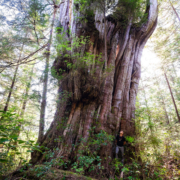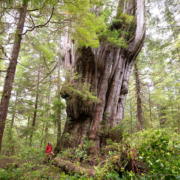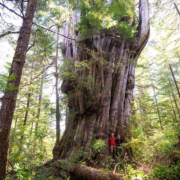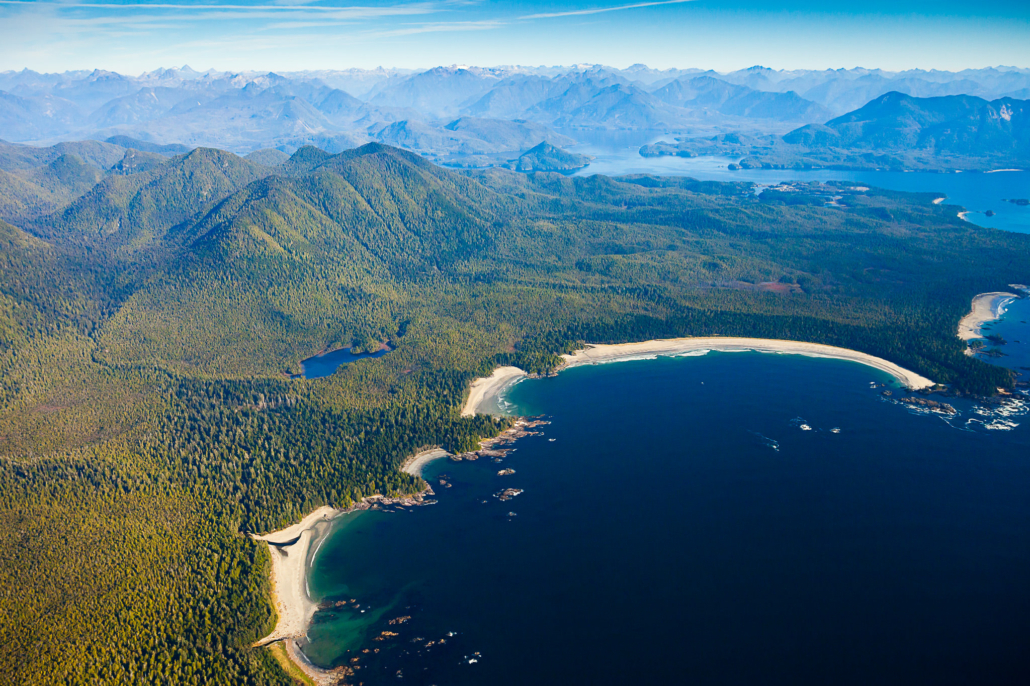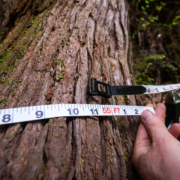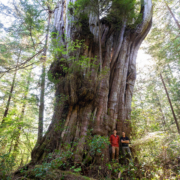Photo of Giant Old-Growth Cedar Wins Prestigious International Award
For Immediate Release
June 21, 2024
Ancient Forest Alliance Photographer TJ Watt awarded Royal Geographical Society Earth Photo 2024 prize for Image of the Enormous Tree in Clayoquot Sound, Canada, featured on CNN and in The Guardian.
The award coincides with the largest old-growth protected areas victory in decades announced earlier this week in Clayoquot Sound, including for the forest pictured.
Ancient Forest Alliance Photographer and Campaigner TJ Watt has received an award in Earth Photo 2024, an international photography competition currently on display at the Royal Geographical Society in London, UK. His award-winning image, titled Flores Island Cedar, features a gargantuan redcedar tree – perhaps the most impressive tree in Canada – with Tyson Atleo, an Indigenous Hereditary Representative of the local Ahousaht people, standing next to the tree’s base providing a sense of scale. Watt located the enormous tree in 2022 on Flores Island in Clayoquot Sound in the unceded territory of the Ahousaht on western Vancouver Island in British Columbia, Canada. The contest, which saw over 1900 entries from around the world and 11 award winners, celebrates photography and moving images that tell compelling stories about our planet, its inhabitants, its beauty, resilience and fragility.
“I’m thrilled and honoured to have received an award in the Earth Photo 2024 contest. I always hope my images of old-growth forests reach as wide an audience as possible, inspiring people and raising global awareness of the need to protect them. The tree in the winning image is the largest one I’ve ever found in nearly 20 years of searching for big trees in BC. It’s more than 17 feet (5 meters) wide near its base, 151 feet tall (46 meters), and likely well over a thousand years old, given its size. Unlike most other trees, it grows wider as it gets taller, making it perhaps the most impressive tree in the country when you’re standing before it. In the photo, Ahousaht Hereditary Representative Tyson Atleo stands alongside the mammoth-sized trunk, adding a sense of scale during our visit to the tree in 2023”, stated TJ Watt, Photographer & Campaigner with the Ancient Forest Alliance.

Watt’s award-winning image, Flores Island Cedar, features an enormous redcedar tree – perhaps the most impressive tree in Canada – with Tyson Atleo, an Indigenous Hereditary Representative of the local Ahousaht people, standing at the tree’s base providing a sense of scale.
Coincidently, the photo award announcement happened to closely coincide with the biggest old-growth protected areas victory in decades when, earlier this week, the leadership of the Ahousaht, Tla-o-qui-aht First Nation, and BC NDP government declared the protection of 76,000 hectares of land in new conservancies in Clayoquot Sound near Tofino, BC. Most of the lands committed for protection are comprised of some of the grandest and most intact coastal old-growth temperate rainforests on Earth, including the forest where Watt’s winning photo was captured.
“It’s not always the case that the forests featured in my photographs have a happy ending. But in this case, I’m so grateful that they do. The announcement of the new conservancies in Clayoquot is incredible news, and I extend my deepest gratitude to the leadership and vision of the Ahousaht and Tla-o-qui-aht people, who’ve now secured protection for some of the grandest old-growth rainforests on Earth in their territories. Their proper care and stewardship go back thousands of years, and as a result, one can still find themselves standing in magnificent ancient forests home to trees that have lived for more than a millennium. A special thanks to Tyson Atleo and the Ahousaht Guardians for their time spent with me in the woods as well”, stated Watt.
Watt’s image was specifically awarded the National Trust Attingham Award for images that show the work or impact of volunteers protecting habitats under the threat of climate change. A second image of Watt’s titled Fallen Giants, featuring him laying atop a freshly fallen old-growth redcedar tree cut down in Quatsino territory on northern Vancouver Island, was also shortlisted in the competition. Both images were part of a body of work Watt created with support from the Trebek Initiative, which also named him a National Geographic and Royal Canadian Geographical Society Explorer.
The winning images of Earth Photo 2024 have also attracted international attention, with high-profile features in The Guardian and CNN. BC-based photographer Taylor Roades was also awarded for her series Alaska Rust Rivers.
To view the collection of winning images online, visit the Royal Geographical Society website or the Parker Harris website.
“Congratulations to all the shortlisted and winning photographers for their stunning and thought-provoking images. Photography is a powerful tool for raising public awareness about the many issues our fragile Earth faces. Thanks to the Royal Geographical Society, Parker Harris, Forestry England, and all those who made Earth Photo possible, helping to get these images and messages out in front of the world”, stated Watt.
Earth Photo was jointly created in 2018 by Forestry England, The Royal Geographical Society and Parker Harris, one of the leading visual arts consultancies in the UK. For those looking to view the images in person, they will be on display at the Royal Geographical Society in London, UK, from June 18 – August 21, 2024, with additional exhibit times listed here.

